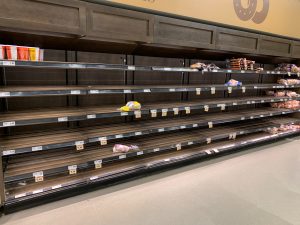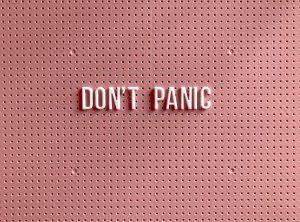Across news outlets and social media, many stories this past week have focused on panic buying — and officials pleading with people not to panic buy. Customers have stocked up on essentials, particularly toilet paper and hand sanitizer, out of fear that the coronavirus pandemic will deplete supermarket supply chains.
Major grocers in Nashville, Tenn., are cutting down on hours to stock shelves and capping how much hand sanitizer and toilet paper they’ll sell after stores there were left bare. Los Angeles Mayor Eric Garcetti is urging residents there to buy food for a week, not months. Supermarkets in New York City are out of stock, too, on all kinds of essential products, and are limiting toilet paper purchases.

Economists would refer to runs on toilet paper as demand-side scarcity. Supply of toilet paper remains largely the same, while demand has suddenly shot up. This is how business professors Shipra Gupta and James Gentry describe scarcity from a supply-and-demand perspective in February 2019 in The International Review of Retail, Distribution and Consumer Research:
“’Supply side scarcity’ can arise when the retailer deliberately controls the supply of the product in the marketplace, i.e., supply is limited intentionally,” write Gupta, an associate professor of business administration at the University of Illinois Springfield, and Gentry, professor emeritus of marketing at the University of Nebraska – Lincoln. “On the other hand, in a ‘demand side scarcity,’ the retailer does not limit the supply of the product but the scarcity arises due to factors like high demand for the product thus leading to stock depletion.”
We rounded up four academic papers journalists should know about panic buying. These studies can inform coronavirus coverage and inspire reporters to ask questions about food supply chains, and to explore historical examples of panic buying and how root causes of a crisis affect how people adapt to a new normal.

American sociologist Lowell Juilliard Carr, writing in the American Journal of Sociology in September 1932, provides some guidance for contextualizing the current situation in the article “Disaster and the Sequence-Pattern Concept of Social Change”:
“Not every windstorm, earth-tremor, or rush of water is a catastrophe,” he writes. “A catastrophe is known by its works; that is to say, by the occurrence of disaster. So long as the ship rides out the storm, so long as the city resists the earth-shocks, so long as the levees hold, there is no disaster. It is the collapse of the cultural protections that constitutes the disaster proper.”
Urban Food Supply Chain Resilience for Crises Threatening Food Security: A Qualitative Study
Amelie A. Hecht, Erin Biehl, Daniel J. Barnett and Roni A. Neff. Journal of the Academy of Nutrition and Dietetics, February 2019.
Through a survey of 26 organizations in Baltimore, the authors provide a glimpse of how well the food supply chain there could withstand a sudden disruption. The organizations included non-profits that focus on improving access to food, and businesses like retailers and producers that sell and provide food.
“Populations with social and economic disadvantages are particularly vulnerable to the impact of food system disruptions,” the authors write. “In Baltimore, nearly one quarter of households experience food insecurity, meaning that they have limited or uncertain access to adequate food.”
The authors used 10 factors to measure resilience: formal emergency planning, staff training, staff attendance, food supply backup, food suppliers, infrastructure, location, service providers, insurance, and whether the organization identified lessons learned after a disruptive event. Large, better resourced organizations with national reach and government affiliations were more resilient in their ability to fulfill their missions during times of acute crisis. Smaller organizations in the study were less prepared and often lacked formal disaster backup plans.
The paper raises an important question for journalists to ask in the communities they cover: Are local and regional food supply chains ready to weather panic buying brought on by the coronavirus storm? But the paper also has limits. For one, it is small in scope. Also, the authors’ definitions of ‘large’ and ‘small’ organizations are subjective, so it might be difficult to compare their conclusions to other studies.
“Additionally, findings may not be generalizable to rural and suburban settings, cities that are considerably smaller or larger, or areas outside the U.S.,” the authors write.
The gist: “Hazards that disrupt the local and nonlocal food systems are likely to increase in severity and frequency in the coming years. To ensure reliable access to safe food for all people, food system organizations must strengthen their operations to safeguard against diverse potential threats.”
Manufacturer, Retailer and Consumer Misbehavior in the United States during the Second World War
Jennifer Mower and Elaine Pedersen. Fashion, Style & Popular Culture, January 2018.
If what William Shakespeare wrote in The Tempest is true — that what’s past is prologue — then this look at hoarding during World War II may be instructive for the current pandemic.
In 1941, when the U.S. entered the war, American consumers began hoarding fabric and clothing.
“This fear was not unfounded; many were old enough to recall the scarcities of clothing and textiles during the previous World War,” the authors write.
According to the paper, retailers in and around Akron, Ohio, stockpiled enough of some clothing items to last two years. In a 1942 editorial, the Los Angeles Times called hoarding a “mistake.” Mixed messages from the media — reports of hoarding and newspapers at the same time warning against hoarding — “resulted in various misbehaviors,” the authors explain.
“Our purpose is to explore and analyze media coverage of these misbehaviors, particularly of outerwear, in order to better understand how apparel and textile companies adjusted their retail strategies because of the War and how this impacted civilian consumption in the years during the war and in the months after,” they write.
The federal government established the now defunct Office of Price Administration in January 1942 to prevent price hikes of retail goods and services, and to ration materials needed for the war. By April 1945, the agency had collected more than $1.5 million in fines from retailers that had busted price ceilings. Jennifer Mower and Elaine Pedersen examined numerous commercial advertisements, news articles and editorials in The New York Times, Los Angeles Times, Women’s Wear Daily, Vogue and other publications. Sales pitches incorporated wartime themes, like patriotism, but still put fashion first — and sales thrived.
The gist: “Consumer fear coupled with manufacturer and retailer advertisements helped to drive wartime apparel sales, even with the federal government urging the apparel industry to reduce their wartime sales pitches and temper store and product advertisements so that there was no unnecessary buying; apparel industry compliance varied.”
The Run on Daily Foods and Goods after the 2011 Tohoku Earthquake
Masahiro Hori and Koichiro Iwamoto. The Japanese Political Economy, December 2014.
During the afternoon of March 11, 2011, a 9.1-magnitude earthquake struck 81 miles off the coast of the city of Sendai on the east coast of Japan, in the Tohoku region. Thirty-foot ocean waves followed. More than 22,000 people were killed or went missing following the quake and tsunami, both of which contributed to the Fukushima nuclear disaster. The meltdown happened in Okuma, about 150 miles north of Tokyo.
Looking at purchase data from 12,000 randomly selected households two months before and after the earthquake, Masahiro Hori and Koichiro Iwamoto observe how people, particularly those in the Tokyo metropolitan area, changed their consumption behavior across 10,000 products.
“While expenditures in western Japan remained largely unaffected, average daily expenditures by households residing in the Tokyo metropolitan area surged immediately after the earthquake, implying widespread panic buying, while expenditures by households in the three disaster-affected prefectures dropped substantially,” the authors write.
Panic buyers in Tokyo scooped up anything on the shelves without apparent rhyme or reason, according to the authors.
“Households that did engage in panic buying appear to have done so quite randomly for a wide range of products (purchasing rice, bread, noodles, and whatever they could lay their hands on),” they write.
The gist: “We found that households in the Tokyo metropolitan area, households with a larger number of family members, households in urban areas, and households with a middle-aged or older full-time homemaker wife were likely to engage in panic buying.”
Disasters and Community Resilience: Spanish Flu and the Formation of Retail Cooperatives in Norway
Hayagreeva Rao and Henrich R. Greve. The Academy of Management Journal, January 2017.
Whether communities are resilient or crumble in the face of adversity may depend on who people blame for a crisis: nature or humankind?
“We find that disasters attributed to other community members weaken cooperation, increase suspicion and distrust of the other, and lead to a long-term (with a declining effect) reduction in organization building,” write Hayagreeva Rao and Henrich Greve.
The authors analyze how Nordic communities responded to two crises: the Spanish Flu of 1918 and spring frost, historically a problem for farmers in Norway. Communities attribute the frost to nature. The Spanish Flu killed 20 million worldwide, including 15,000 Norwegians. The disease was, by definition, naturally occurring, but was portrayed in news outlets around the world as an enemy combatant. Norwegians tired of seeing death notices in their newspapers, and neighbors began to fear one another, according to the authors.
In response to spring frost, farmers created shared insurance and storage, like community grain banks. Public ownership remains a vital part of Norwegian economics, and today one quarter of retail grocery sales by revenue happen at cooperative stores, according to Rao and Greve. Analyzing historical data from the Cooperative Association in Norway, the authors find that the Spanish Flu decreased rates of retail cooperatives being founded, while spring frost increased their founding.
The gist: “Our study suggests that there is an important difference in the effects on the community and local organizations not just based on occurrence and magnitude but also the causal framing of the disaster.”
For more on the coronavirus pandemic, learn how oil prices have been affected, the inequality of telework and how online schooling affects student performance. Also, check out some research on how the virus is infecting the economy, plus our 5 tips for journalists covering the outbreak.
